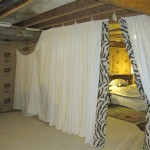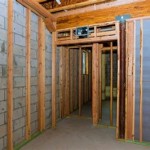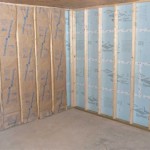How to Remove Dampness from a Basement
A damp basement is a common problem for homeowners, often resulting from a variety of factors that allow moisture to infiltrate the space. Addressing dampness promptly is crucial, as it can lead to mold growth, structural damage, and compromised indoor air quality. Understanding the causes and implementing effective solutions are essential for maintaining a dry and healthy basement environment.
The first step in tackling basement dampness is to identify the source of the moisture. This requires a thorough inspection of both the interior and exterior of the property. Potential sources include groundwater infiltration, condensation, leaky pipes, and poor ventilation. Once the source is identified, appropriate remediation strategies can be implemented.
Identifying the Source of Basement Dampness
Pinpointing the origin of the dampness is critical for selecting the most effective removal methods. A systematic approach involving both visual inspection and, in some cases, professional assessment, is often necessary.
Begin with a visual inspection of the basement walls and floor. Look for signs of water stains, discoloration, efflorescence (a white, powdery deposit on the surface of concrete or masonry), and mold growth. Pay close attention to areas near cracks, seams, and where the walls meet the floor. These are common entry points for water.
Check for condensation on pipes and cold surfaces. Condensation occurs when warm, moist air comes into contact with a cold surface, causing water to condense. This is more common during warmer months when the temperature difference between the basement and the outside air is significant.
Examine the exterior of the house for potential sources of water intrusion. Check the grading around the foundation to ensure that it slopes away from the house. Improper grading can direct rainwater towards the foundation, increasing the risk of water seepage into the basement. Inspect gutters and downspouts to ensure they are clean, functional, and direct water away from the foundation.
Look for cracks in the foundation walls. Even small cracks can allow water to enter the basement. These cracks may be visible from both the interior and exterior of the foundation. Consider any recent plumbing work or potential leaks in water pipes within the house.
If the source of the dampness is not readily apparent, consider enlisting the help of a professional building inspector or basement waterproofing specialist. They can use specialized equipment, such as moisture meters and infrared cameras, to detect hidden moisture problems and identify the source of the dampness. They can also assess the overall condition of the foundation and recommend appropriate remediation strategies.
Enhancing Ventilation and Managing Condensation
Improving ventilation is a vital step in removing dampness and preventing its recurrence. Proper ventilation helps to reduce humidity levels in the basement, discouraging mold growth and minimizing condensation. Several methods can be employed to enhance ventilation and manage condensation.
Install a dehumidifier in the basement. Dehumidifiers remove excess moisture from the air, effectively lowering humidity levels. Choose a dehumidifier with a capacity appropriate for the size of the basement. Regularly empty the water collection tank or connect the dehumidifier to a drain for continuous operation. Dehumidifiers are particularly useful in basements with high humidity levels or those prone to condensation.
Increase airflow by opening windows and using fans. Opening windows allows fresh air to circulate through the basement, helping to dry out damp areas. However, this is only effective when the outside air is drier than the air inside the basement. Using fans can also improve airflow, especially in areas with poor natural ventilation. Position fans to circulate air throughout the basement, focusing on damp areas.
Insulate cold surfaces to reduce condensation. Insulating pipes, walls, and other cold surfaces can help to prevent condensation by reducing the temperature difference between the surface and the surrounding air. Pipe insulation is readily available at hardware stores and is easy to install. Insulating basement walls can also help to reduce condensation and improve energy efficiency.
Ensure proper ventilation of appliances that produce moisture. Clothes dryers, for example, should be vented to the outside to prevent moisture from being released into the basement. If the dryer is not properly vented, moisture can accumulate in the basement, contributing to dampness and mold growth.
Consider installing an exhaust fan in the basement. An exhaust fan can help to remove moist air from the basement, particularly in areas where moisture is likely to accumulate, such as near showers or laundry areas. Choose an exhaust fan with a capacity appropriate for the size of the basement and ensure it is properly vented to the outside.
Addressing Water Intrusion and Improving Drainage
When the source of basement dampness is water intrusion, addressing the problem requires a more comprehensive approach. This may involve repairing foundation cracks, improving drainage around the foundation, and implementing waterproofing measures to prevent water from entering the basement.
Repair any cracks in the foundation walls. Cracks in the foundation are a common entry point for water. Small cracks can be sealed with epoxy or polyurethane crack sealant. Larger cracks may require professional repair, such as patching with concrete or applying a waterproof membrane. Properly sealing cracks can significantly reduce water intrusion.
Improve drainage around the foundation. Ensure that the grading around the foundation slopes away from the house to direct rainwater away from the foundation walls. This will help to prevent water from pooling around the foundation and seeping into the basement. Consider installing a French drain, which is a perforated pipe buried in a gravel-filled trench around the foundation. A French drain collects groundwater and directs it away from the house.
Install a sump pump. A sump pump is a device that removes water that accumulates in a sump pit, typically located in the lowest part of the basement. Sump pumps are particularly useful in areas with high water tables or those prone to flooding. The sump pump automatically pumps water out of the pit and away from the foundation, preventing water from accumulating in the basement.
Apply a waterproof sealant to the interior or exterior of the foundation walls. Waterproof sealants can help to create a barrier against water intrusion. Interior sealants are typically applied to the inside of the basement walls, while exterior sealants are applied to the outside of the foundation. Choose a sealant that is specifically designed for basement waterproofing and follow the manufacturer's instructions carefully.
Consider installing a vapor barrier. A vapor barrier is a thin sheet of plastic or other material that is installed on the inside of the basement walls. The vapor barrier helps to prevent moisture from passing through the walls and into the basement. This is particularly useful in basements with high humidity levels or those prone to condensation.
Regrading the landscape is essential to prevent water from pooling near the foundation. The ground should slope away from the foundation by at least six inches over the first ten feet. This slope ensures that rainwater flows away from the house, reducing the risk of water infiltration into the basement.
Extending downspouts can also significantly improve water management. Downspouts should extend at least four to six feet away from the foundation to prevent water from saturating the soil around the basement walls. Using downspout extensions or connecting them to underground drainage systems ensures that water is effectively channeled away from the house.
Addressing basement dampness requires a multifaceted approach, starting with accurate identification of the moisture source. Effective ventilation and condensation management are crucial, but when water intrusion is the primary cause, structural repairs and drainage improvements become necessary. By implementing these strategies, homeowners can create a drier, healthier basement environment and protect their property from the detrimental effects of moisture.

Moisture In Basements Causes And Solutions Umn Extension

6 Causes Of Basement Moisture How To Fix Them

Cottage Q A What S Causing My Basement Dampness Life

3 Ways To Prevent Humidity In A Basement Wikihow

What Causes Dampness In A Basement

What Causes Dampness In A Basement

How To Get Rid Of Dampness In A Basement Epp Foundation Repair

Moisture In Basements Causes And Solutions Umn Extension

Things To Know About Basement Moisture Control Blog

What To Do When Your Basement Floor Is Damp Smart Tips
Related Posts







